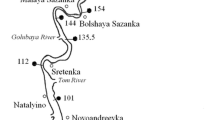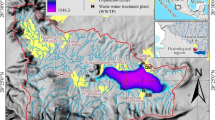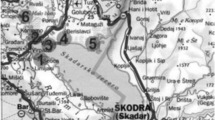Abstract
Five sediment cores from the fresh water region of the Vembanad wetland system were studied for the trace element contents The average concentration of iron, manganese, nickel, copper, zinc, cadmium, lead, mercury and chromium were determined. The core samples were collected using gravity type corer, digested with a mixture of nitric acid and perchloric acid and analyzed by atomic absorption spectrophotometry. Heavy metals such as iron, copper, nickel and zinc reported enrichment towards the surface of the core sediment sample collected from the centre of the lake. Lead, cadmium and mercury showed uniform distribution through out the core. Quality of the sediments were evaluated based on sediment quality guidelines, pollution load index, sum of toxic units and with effect range low/effect range median and threshold effect level/probable effect level values of Environmental Protection Agency guidelines. The degree of contamination for each station was determined. The concentration of different heavy metals has been compared with the world average concentration of shale values. Results of the analysis showed that Vembanad lake is facing serious metal pollution with increased rate of deposition.
Similar content being viewed by others
References
Akay, H. A.; Karapire, C. O., (2003). Study of heavy metal pollution and speciation in Butak menders and Gediz river sediments. Water Res., 37(3), 813–822 (10 pages).
Alemdaroglu, T.; Onur, E.; Erkakan, F., (2003). Trace metal levels in surface sediments of lake Manyas, Turkey and tributary rivers. Int. J. Environ. Stud., 60(3), 287–298 (12 pages).
Al-Masri, M. S.; Aba, A.; Khalil, H.; Al-Hares, Z., (2002). Sedimentation rates and pollution history of a dried lake: Al-Qteibeh Lake., Sci. Total Environ., 293(1–3), 177–189 (13 pages).
Bakan, G.; Ozkoc. H. B., (2007). An ecological risk assessment of the impact of heavy metals in surface sediments on biota from the mid-Black Sea coast of Turkey. Int. J. Environ. Stud., 64(1), 45–57 (13 pages).
Balachandran, K. K.; Joseph, T.; Nair, K. K. C.; Nair, M.; Joseph, P. S., (2002). The complex estuarine formation of six rivers (Cochin backwaters system on west coast of India)-Sources and distribution of trace metals and nutrients. APN/ SASCOM/LOICZ regional workshop on assessment of material fluxes to the coastal zone in South Asia and their Impacts. Negombo, 8–11 December. Sri Lanka.
Balachandran, K. K.; Joseph, T.; Nair, M.; Sankaranarayanan, V. N.; Das, V. K.; Sheeba, P., (2003). Geochemistry of surficial sediments along the central southwest coast of India-seasonal changes in regional distribution. J. Coast. Res., 19(3), 664–683 (20 pages).
Bellucci, L. G.; El Moumni, B.; Collavini, F.; Frignani, M.; Albertazzi, S., (2003). Heavy metals in Morocco Lagoon and river sediments. J. Phys., 107(1), 139–142 (4 pages).
Bertolotto, R. M.; Tortarolo, B.; Frignani, M.; Bellucci, L. G.; Albanese, S.; Cuneo, C., (2003). Heavy metals in coastal sediments of the Ligurian sea off Vado Ligure. J. Phys., 107(1), 159–162 (4 pages).
Bonnevie, N. L.; Huntley, S. L.; Found, B. W.; Wenning, R. J., (1994). Trace metal contamination in surface sediments from Newark Bay, New Jersey. Sci. Total Environ. 144(1), 1–16 (16 pages).
Borretzen, P.; Salbu, B., (2002). Fixation of Cs to marine sediments estimated by a stochastic modeling approach. J. Environ. Radio., 61(1), 1–20 (20 pages).
Cohen, A. S., (2003). Paliolimnology, Oxford University Press, New York.
Hakanson, L., (1980). Ecological risk index for aquatic pollution control. A sedimentological approach. Water Res., 14(5), 975–1001 (26 pages).
Harikumar, P. S.; Madhavan, K.; Shimjidha, P.; Bindu, K. R.; (2007). Study on hydrochemistry and sediment quality of Vembanad Lake in the southwest (Kerala) coast of India. Eco-chronicle., 2(2), 69–80 (12 pages).
Heyvaert, A. C.; Reuter, J. E.; Sloton, D. G.; Goldman, C. R., (2000). Paleo-limnological reconstruction of historical atmospheric lead and mercury deposition at Lake Tahoe. California-Nevada. Environ. Sci. Tech., 34(17), 3588–3597 (10 pages).
Jain, C. K., (2004). Metal fractionation study on bed sediments of River Yamuna, India. Water Res., 38(3), 569–578 (10).
Karbassi, A. R.; Nabi-Bidhendi, G. R.; Bayati, I., (2005). Environmental geochemistry of heavy metals in a sediment core off Bushehr, Persian Gulf. Iran. J. Environ. Health. Sci. Eng., 2(4), 255–260 (6 pages).
Lee, S. V.; Cundy, A. B., (2001). Heavy metal contamination and mixing process s in sediments from the Humber estuary, Eastern England. Estuaries Coast. Shelf Sci., 53(5), 619–636 (18 pages).
Lopez, P.; Lluch, X., (2000). Sediment geochemistry of a meromictic coastal lagoon, ESCIBOLLAR(MAJORCA, SPAIN). Limnetica, 18, 15–27 (13 pages).
MacDonald, D. D.; Ingersoll, C. G.; Berger, T. A., (2000). Development and evaluation of consensus-based sediment quality guidelines for freshwater ecosystems. Arch. Environ. Contam. Toxicol., 39, 20–31 (12 pages).
Mohamed, A. W., (2005). Geochemistry and sedimentology of core sediments and the influence of human activities, Qusier, Safaga and Hasighada Harbors, Red sea coast, Egypt. Egyptian J. Aquatic Res., 31(1), 92–103 (12 pages).
Mudholkar, A. V.; Pattan, J. N.; Parthiban, G., (1993). Geochemistry of deep sea sediment cores from the Central Ocean Basin. Indian J. Mar. Sci., 22, 241–246 (6 pages).
Ouseph, P. P., (1987). Heavy metal pollution in the sediments of Cochin estuarine system. National seminar on estuarine management, 123–127.
Pederson, F.; Bjorestad, E.; Anderson, H. V.; Kjolholt, J.; Poll, C., (1998). Characterization of sediments from Copenhagen Harbour by use of biotests. Water Sci. Tech., 37(6–7), 233–240 (8 pages).
Perin, G.; Bonardi, M.; Fabris, R.; Simoncini, B.; Manente, S.; Tosi, L.; Scotto, S., (1997). Heavy metal pollution in central Venice Lagoon bottom sediments: evaluation of the metal bioavailability by geochemical speciation procedure. Environ. Tech., 18, 593–604 (12 pages).
Pillai, V. K.; Valsala, K. K., (1995). Seasonal variation of some metals in bivalve mollusk Sunetta scripta from the Cochin coastal waters. Indian J. Mar. Sci., 24(2), 113–115 (3 pages).
Sadiq, M., (1992). Toxic metal chemistry in marine environments. 237–241.
Sankaranarayanan, V. N.; Jayalakshmy, K. V.; Tresiamma J., (1998). Particulate trace metals in Cochin backwaters: distribution of seasonal indices. Indian J. Fish., 45(3), 321–329 (9 pages).
Satyanarayana, D.; Panigrahy, P. K.; Sahu, S. D., (1994). Metal pollution in harbor and coastal sediments of Visakhapatnam, east coast of India. Indian J. Mar. Sci., 23(1), 52–54 (3 pages).
Taylor, S. R., (1972). Abundance of chemical elements in the continental crust: a new table. Geochim. Cosmochim. Acta., 28(8), 1273–1285 (13 pages).
Tomlinson, D. C.; Wilson, J, G.; Harris, C. R.; Jeffery, D. W., (1980). Problems in the assessment of heavy metals levels in estuaries and the formation of a pollution index. Helgol. Wiss. Meeresunters, 33(1–4), 566–575 (10 pages).
UNEP, (1985). Reference methods for marine pollution studies, United Nations Environment Program. Regional seas., 31–39.
Unnikrishnan, P.; Nair, S. M., (2004). Partitioning of trace metals between dissolved and particulate phases in a typical backwater system of Kerala, India., Int. J. Environ. Studies., 61(6), 659–676 (18 pages).
USEPA, (1999). SW-846.,Reference methodology. Standard opening procedure for the digestion of soil/sediment sample using a hot plate/beaker digestion technique, Chicago, IL.
Venugopal, P.; Sarala Devi, K.; Remani, K. N.; Unnithan, R. V., (1982). Trace metal levels in sediments of the Cochin backwaters. Mahasagar, 15(4), 205–214 (10 pages).
Weis, D. A.; Callaway, J. C.; Gersberg, R. M., (2001). Vertical accretion rates and heavy metal chronologies in wetland sediments of the Tijuana Estuary. Estuaries, 24(6A), 840–850 (11 pages).
Author information
Authors and Affiliations
Corresponding author
Rights and permissions
About this article
Cite this article
Harikumar, P.S., Nasir, U.P. & Rahman, M.P.M. Distribution of heavy metals in the core sediments of a tropical wetland system. Int. J. Environ. Sci. Technol. 6, 225–232 (2009). https://doi.org/10.1007/BF03327626
Received:
Revised:
Accepted:
Published:
Issue Date:
DOI: https://doi.org/10.1007/BF03327626




